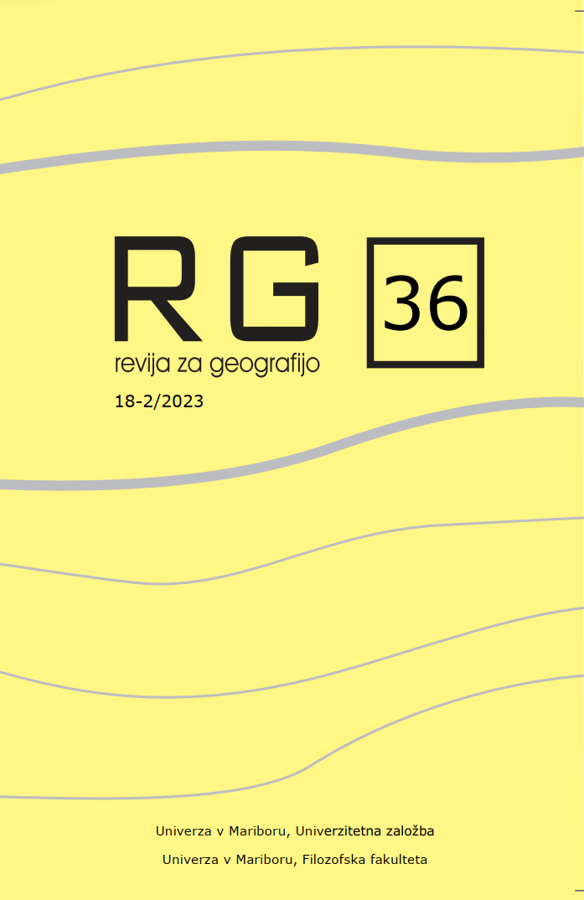Tourism Gentrification in a Small Mediterranean Town: Impacts and Implications for Urban Climate Resilience
DOI:
https://doi.org/10.18690/rg.18.2.3416Keywords:
tourism gentrification, climate resilience, Piran, cultural heritage, social dynamics, community disaster resilience, public spaces, overtourism, interviewsAbstract
This study explores the relationship between tourism gentrification and urban climate resilience in Piran. It focuses on socio-economic changes due to tourism and their implications for the town's ability to respond to climate-related challenges. Using mixed methods, it evaluates the effects on architectural authenticity, public spaces, and community dynamics. The findings reveal conflicts between heritage preservation and tourism, highlighting integration challenges for newcomers in enhancing climate resilience. The paper advocates for strategies balancing sustainable tourism with cultural heritage preservation, offering solutions for similar towns in the Mediterranean.
Downloads
References
Agencija Republike Slovenije za javnopravne evidence in storitve (AJPES). Register nastanitvenih obratov. Retrieved from https://www.ajpes.si/Registri/Drugi_registri/Register_nastanitvenih_obratov/Splosno (Accessed December 3, 2023).
Akhavan, M., & Bobic, S. (2022). Tourism gentrification in Mediterranean heritage cities: The necessity for multidisciplinary planning. Cities: the international journal of urban policy and planning, 124, 1-6. https://doi.org/10.1016/j.cities.2022.10361
Chamizo-Nieto, F. J., Nebot-Gómez de Salazar, N., Rosa-Jiménez, C., & Reyes-Corredera, S. (2023). Touristification and Conflicts of Interest in Cruise Destinations: The Case of Main Cultural Tourism Cities on the Spanish Mediterranean Coast. Sustainability, 15(8), 64031-26.
Cocola-Gant, A. (2018). Tourism gentrification. In L. Lees & M. Phillips (Eds.), Handbook of Gentrification Studies (pp. 281-293).
Cutter, S. L., Ash, K. D., & Emrich, C. T. (2014). The geographies of community disaster resilience. Global environmental change, 29, 65-77. https://doi.org/10.1016/j.gloenvcha.2014.08.005
García-Hernández, M., De la Calle-Vaquero, M., & Yubero, C. (2017). Cultural heritage and urban tourism: Historic city centres under pressure. Sustainability, 9(8), 1346. https://doi.org/10.3390/su9081346
Geertz, C. (1973). The Interpretation of Cultures.
Guzej, A. (2018). Problematika počitniških bivališč v starem mestnem jedru Pirana z vidika njihovih lastnikov in domačinov: magistrsko delo. (Doctoral dissertation, Univerza na Primorskem, Fakulteta za humanistične študije.).
Hametz, M. E. (2005). Making Trieste Italian, 1918-1954. Woodbridge: Boydell Press.
Hudnik, Š. (2015). Sociološka analiza: Slovenska Istra. Fakulteta za arhitekturo.
Kalc, A. (2019). The other side of the “Istrian exodus”: immigration and social restoration in Slovenian coastal towns in the 1950s. Dve domovini, 49, 145-162. https://doi.org/10.3986/dd.v0i49.7258
Kočevar, B., & Plazar Mlakar, M. (2006). Piran – moje mesto: Strategija prenove mesta Piran. Strokovne podlage. Občina Piran, Studio Mediterana.
Koderman, M. (2014). Spatial analysis of second homes in the municipality of Piran. Academica turistica, 7(2), 179-191.
Kralj, E., Kumer, P., & Meulenberg, C. J. (2023). Coastal Flood Risk Assessment: An Approach to Accurately Map Flooding through National Registry-Reported Events. Journal of Marine Science and Engineering, 11(12), 2290. https://doi.org/10.3390/jmse11122290
Kumer, P., Meulenberg, C. J. W., & Kralj, E. (2022a). Challenges for planning climate change resilience through the co-creation living lab approach in the Mediterranean coastal town of Piran. Journal for Geography/Revija za geografijo, 17(2), 89-106. https://doi.org/10.18690/rg.17.2.2737
Kumer, P., Meulenberg, C. J. W., & Mackenzie Hawke, S. (2022b). Piran coastal city living lab (CCLL): Challenges and opportunities. In SCORE consortium meeting (pp. 28-30).
Mazzola, F., Pizzuto, P., & Ruggieri, G. (2019). The role of tourism in island economic growth and resilience: A panel analysis for the European Mediterranean countries
(2000–2015). Journal of Economic Studies, 46(7), 1418–1436. https://doi.org/10.1108/JES-04-2019-0172
Milano, C., Cheer, J. M., & Novelli, M. (Eds.). (2019). Overtourism: Excesses, discontents and measures in travel and tourism. Cabi.
Pavel, F., & Romeiro, P. (2023). Challenges of Public Policies for Tourism in Medium-Sized Cities in Europe: The Cases of Lisbon and Porto (Portugal). GOT -: Revista de Geografia e Ordenamento do Território, 25, 129-150(25). https://doi.org/10.17127/got/2023.25.007.
Pirjevec, J., Klabjan, B., & Bajc, G. (Eds.). (2006). Osimska meja: Jugoslovansko-italijanska pogajanja in razmejitev leta 1975. Založba Annales.
Pletikosić, I. (2001). Vpliv selitvenih gibaj na spreminjanje števila prebivalcev v Piranu sredi 20. stoletja. Annales: Ser. hist. sociol., 11(2), 387-394.
Pletikosićm I. (2002). “Čiščenje” v Piranu (1945-1948). Acta Histriae, 10(2), 465-492.
Pletikosić, I. (2021). Piran v popisih prebivalstva.
Pletikosić, I. (2000). Migracije v Piranu med drugo svetovno vojno in neposredno po njej. Annales (10)1, 217–30.
Pomorski muzej. (2023). Digitalizacija topografskega zemljevida Pirana iz leta 1889 [Digitization of the topographic map of Piran from 1889]. Retrieved December 17, 2023, from https://pomorskimuzej.si/sl/dogodki/2023/09/27/digitalizacija-topografskega-zemljevida-pirana-iz-leta-1889
Razpotnik, B. (2020). V prvem polletju 2020 dve tretjini več medobčinskih selitev kot v istem obdobju leta 2019. Retrieved from https://www.stat.si/StatWeb/News/Index/9232
Salee, A., Rasoolimanesh, S. M., & Kusumo, C. M. L. (2022). Tourism Impacts on Destinations: Insights from a Systematic Review of Literature. Asia-Pacific Journal of Innovation in Hospitality & Tourism, 11(1).
Smith, V. L., & Eadington, W. R. (Eds.). (1992). Tourism alternatives: Potentials and problems in the development of tourism. University of Pennsylvania press.
Statistični urad Republike Slovenije (SURS). (2023, December 3). SiStat. Retrieved from https://pxweb.stat.si/
Wardekker, A., Doloisio, B. N., Sandré, T., & Huctin, J. M. (2022). Framework for analyzing resilience narratives. Deliverable D5.1, SeMPER-Arctic project
Weber, I. (2007). Heritage Narratives on the Slovenian Coast: The Lion and the Attic. In Cultural Heritages as Reflexive Traditions (pp. 158-170). London: Palgrave Macmillan UK.
Yang, E., Kim, J., Pennington-Gray, L., & Ash, K. (2021). Does tourism matter in measuring community resilience?. Annals of Tourism Research, 89, 103222. https://doi.org/10.1016/j.annals.2021.103222
Downloads
Published
Issue
Section
License
Copyright (c) 2023 Peter Kumer, Erik Kralj, Cécil Meulenberg

This work is licensed under a Creative Commons Attribution 4.0 International License.
